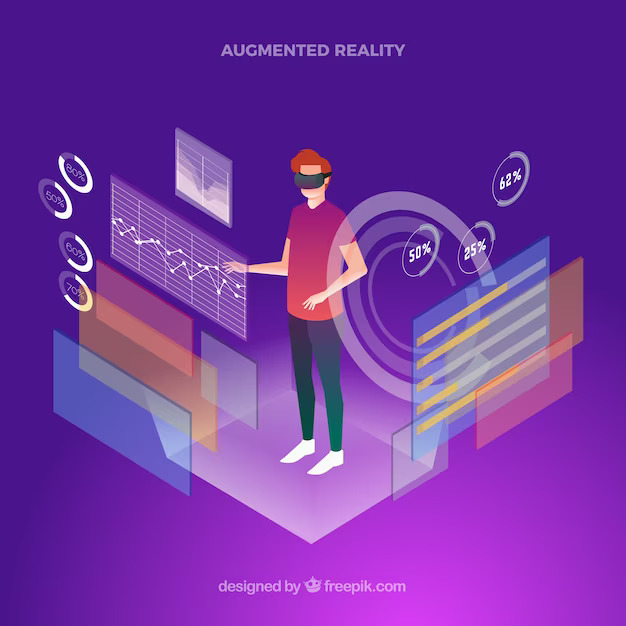Augmented Reality in Education
Augmented reality (AR) is a technology that overlays virtual information onto the actual environment by detecting and tracking real-world objects using cameras and other sensors. This technology has the ability to transform the way we learn and teach by producing immersive and engaging educational experiences that improve students' comprehension and retention of material.
How Augmented Reality Works:
Augmented reality (AR) technology merges the physical and digital worlds to create a new, mixed reality with which users may engage in real time. AR is often accessed via a smartphone or tablet device that detects and tracks real-world things using its camera and other sensors. The gadget then superimposes virtual information over the actual world, which the user may see through the device's screen.
AR is classified into two types: marker-based and markerless. Marker-based AR activates the virtual information overlay by using a physical marker, such as a QR code or picture. Markerless AR detects the user's location and motions using sensors such as GPS or accelerometers and overlays virtual information appropriately.
AR technology is already being employed in many facets of daily life, from popular smartphone apps such as Snapchat and Instagram filters to games such as Pokemon Go. AR is used in these apps to add virtual objects or effects to the user's camera view, resulting in an interactive and immersive experience.
Augmented Reality in Education:
The use of augmented reality (AR) in education has grown in popularity in recent years. AR has the ability to transform the way students learn by offering an immersive and interactive learning experience that goes beyond standard classroom approaches.
Increased student involvement and motivation is one of the key advantages of employing AR in education. AR technology may create a sense of excitement and wonder, which can assist catch students' attention and keep them focused on the topic. This can lead to higher learning outcomes and a better comprehension of complicated subjects.
AR can also boost information retention by creating a more memorable learning experience. Students may perceive and interact with complicated subjects in a way that makes them more likely to recall and grasp the information by utilizing AR to build interactive and immersive simulations.
AR can improve students' entire learning experience in addition to increasing engagement and retention. AR, for example, may be used to create virtual field excursions that allow kids to go across the world or learn about historical events. AR may also be used to build simulations of scientific processes or anatomical structures, allowing students to engage in hands-on learning that is difficult to recreate in a typical classroom setting.
There are several examples of AR being used in education. Some language learning applications, for example, employ augmented reality to overlay virtual labels over real-world items to help pupils acquire new vocabulary. AR simulations that allow students to study the human body or scientific processes in a more participatory way can bring science and anatomy teachings to life. Students can take virtual field trips to other regions of the world or investigate historical events or cultural attractions.
Examples of Augmented Reality in Education:
There are many examples of how augmented reality (AR) is being used in education to enhance learning and engage students. Here are just a few examples of AR in action:
Anatomy Lessons:
Anatomy 4D" is an augmented reality program that allows students to examine the human anatomy in 3D by superimposing virtual organs and systems over a physical marking. This software may assist students comprehend the human body and its operations while also making studying more fascinating and interactive.
Language Learning:
The software "Word Lens" use augmented reality to superimpose virtual translations on real-world signs and papers. This is particularly useful for language learners attempting to traverse a distant country or study unfamiliar literature.
Virtual Field excursions:
The program "Google Expeditions" allows students to take virtual field excursions throughout the world, allowing them to learn about diverse cultures and settings without ever leaving the classroom. This program may help bring history and geography courses to life, making learning more immersive and memorable.
Science Simulations:
The software "Elements 4D" allows students to investigate the characteristics and interactions of many elements in a 3D, augmented reality environment. This is especially beneficial for students who struggle to visualize scientific topics or who require more hands-on learning.
Challenges and Limitations of Augmented Reality in Education:
While augmented reality (AR) has the potential to transform the way students learn, there are several problems and constraints to consider when using AR into the classroom.
One of the most significant obstacles is the expense. AR technology is not cheap, and many schools may lack the funds to acquire the required gear and software. Furthermore, certain pupils, particularly those from lower-income households, may not have access to AR-capable gadgets at home.
Another issue is teacher training. While augmented reality can provide a more interesting and participatory learning environment, it also necessitates that teachers have a certain amount of technological skill. Without sufficient training, instructors may struggle to implement AR into their classes successfully or may be unable to address difficulties that develop.
There are additional ethical concerns to consider while employing AR in teaching. For example, there may be worries about data privacy because AR technology frequently gathers and analyzes user data. Furthermore, there may be possible biases in the technology itself, such as the depiction of specific tribes or cultures in AR simulations.
Despite these limitations, schools and educators may take efforts to solve them and make AR more accessible in the classroom. Schools, for example, should seek collaborations with technology businesses to get financing for AR hardware and software. Teachers can also obtain training and professional development chances to expand their technical knowledge.
It is also necessary to evaluate the ethical issues of adopting AR in education. When deploying AR technology, schools and educators should emphasize data privacy and security, and be cognizant of any biases in the technology itself. By being aware of these obstacles and limits, schools and educators may endeavor to ensure that AR is utilized responsibly and effectively in the classroom.
Conclusion:
Augmented reality (AR) has the ability to change the way students learn by making instruction more interesting and interactive. AR is being utilized in a number of ways to increase learning and improve student results, from anatomy courses to virtual field trips.
While incorporating AR into the classroom has its hurdles and limits, schools and educators may take measures to solve these concerns and make AR more accessible to all students. This includes procuring money for augmented reality technology, offering teacher training and professional development opportunities, and being aware of the ethical aspects of employing augmented reality in education.
If you are an educator who is interested in incorporating AR into your teaching, there are many tools and apps available that can help you get started. Some popular AR apps for education include "Anatomy 4D," "Word Lens," "Google Expeditions," and "Elements 4D."
If you are interested in developing your own AR app for education, there are also many augmented reality app development companies that can help you bring your vision to life. These companies specialize in developing AR apps for a variety of industries, including education. By working with an experienced AR app development company, you can ensure that your app is designed to meet the unique needs of your students and provide an engaging and effective learning experience.




Comments
Post a Comment